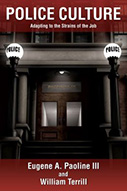Police Culture: Adapting to the Strains of the Job

Authors: Eugene A. Paoline III and William Terrill
Publisher: Durham, NC: Carolina Academic Press, 2013. 194p.
Reviewer: Michael J. Jenkins | July 2014
Paoline and Terrill have published widely on the topic of police culture and related areas. Their recent addition offers an extensive, empirical examination of the elusive and influential phenomenon of police culture. Police culture: Adapting to the strains of the job (Carolina Academic Press, 2014) presents a thorough and systematic study of both the homogenous and heterogeneous elements of police culture. On one end of the spectrum there are those who see a single, shared culture across officers; on the opposite side are those who characterize police culture as varying among officers. Paoline and Terrill seek to portray police culture as including many points on this spectrum.
Whether or not practitioners and researchers recognize it, police culture permeates all aspects of the police occupation and organization. The authors demonstrate this by outlining the key assumptions and methodologies of the foundational research in each of the conceptualizations of police culture; then, in Chapter 2, they trace the importance of police culture throughout the history of the police profession in the United States. They note how police culture adapted to each of the eras of policing. These reviews are useful on their own as an overview of the research on police culture and of police history. They also help to place the current study within its greater scholarly and historical contexts.
The book presents a rich view of police culture within its greater occupational and organizational dimensions. Chapter 3 details the internal and external environments of each department. This chapter serves mostly to orient the reader. It also gives a starting point from which one could compare and reflect on their own police department’s experiences. Chapter 4 then presents the methods and methodology in a way that reads as a “best practices” guide for researchers considering similar types of research. Again, this chapter is useful on its own for students who might undertake a similar approach to the study of police personnel or organizations.
The findings in Chapter 5 suggest that police culture has both homogenous and heterogeneous dimensions. These relate to the police environment, police coping mechanisms, and outcomes of that culture. Though one must be cautious when making the leap between attitudinal, Likert scale measures and a respondent’s actual behaviors, the findings offer considerations for police practitioners and scholars as they contemplate the state of police culture and the police profession. Paoline and Terrill present a multifaceted picture of police culture by distinguishing between those elements that point to a homogeneous occupational culture, and those that suggest more differentiated orientations.
The authors’ interpretations of their findings offer welcome points of intellectual engagement. For example, they find overall support for and disagreement with aspects of community policing. As a result, the authors speculate that the police profession is holding onto parts of the community policing philosophy of the prior era, while also starting to adopt the more crime-fighting orientations of the new era. However, one might also interpret this as indicating a policing profession that is moving toward a more complete adoption of a community policing era as it negotiates the terrain of some new (but still community-based) era. We are just beginning to define this new era. The authors’ elucidation of the historical policing philosophies supports this interpretation. Placing these findings within such a context only enriches the authors’ portrayal of the profession and the culture of police.
The strongest point of the research presented in this book is its expansive approach to the study of police culture. The authors account for multiple aspects of policing environments, the milieu of and history of the policing profession, and the many dimensions of police culture. Paoline and Terrill use a number of methods to do so. As a result, it is an excellent resource for students and researchers who want to better understand or refine their own studies of police culture and associated subjects. Police leaders who wish to understand how to use police culture to change and improve their organizations will also benefit from reading this book.


